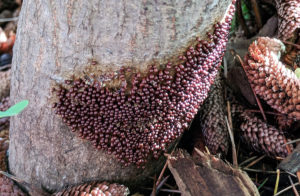Q: I’ve heard slime molds are neither plant nor animal, and that despite being single-celled they can move and even navigate a maze! How can this be? Are there slime molds in the Bay Area? [Michele, a frequent visitor from Toronto]
A: Strolling through a local redwood forest years ago, I came across a huge, bright yellow mass of a slime mold. I vaguely recalled reading that you could grow slime molds on a medium of oatmeal. I brought a bit of the yellow goo home and tried it. My experiment failed miserably; the slime mold shriveled and died horribly. My calling as a pet owner was finished.
Slime molds are weird, but not uncommon. There are two types in the Bay Area. The plasmodial slime molds are nothing more than gigantic single-celled life forms with thousands of nuclei. They develop when tens of thousands of single cells, all with a whiplike appendage called a flagellum, throng together and fuse into one larger cell with a single membrane. Worldwide there are about 500 species; they are often orange or yellow and are probably the easiest single-celled organisms to see with the unaided eye. They can be several inches across and cruise around on the forest floor like giant amoebas engulfing microorganisms such as bacteria and yeast. They also devour decaying vegetation, but apparently not oatmeal!
There are only about 65 species of the cellular slime molds. They are also single cells, but microscopic–they do not form huge plasmodia. They too feed amoeba-style, engulfing mostly living bacteria found in the leaf litter. When they exhaust the local food supply a remarkable event occurs: A chemical signal released by several of the cellular slime molds causes all the surrounding ones to stream together to form a larger colonial organism. Slug-like in appearance, this new mass moves toward sunlight; then fruiting bodies pop up and bear spores. These mature and are released, enabling the slime molds to drift to a new promised land, hopefully full of more edible bacteria. Yummy. . . .
Slime molds’ spore-based reproduction strategy first led biologists to lump them with fungi, along with familiar household molds. But things are not so simple: Slime molds behave like animals when they are feeding and growing, and then more like plants or fungi when in the immobile, reproductive phase. So now they are classified in the kingdom Protista. This diverse group includes many “leftover” organisms that just do not fit into other kingdoms. They are mostly single-celled, like amoebas and dinoflagellates, but also include the multicellular seaweeds.
So on your next winter walk in any deep, damp forest, watch for bright yellow or orange blobs. Just don’t try to feed them oatmeal.
Send your questions to atn@baynature.org.

